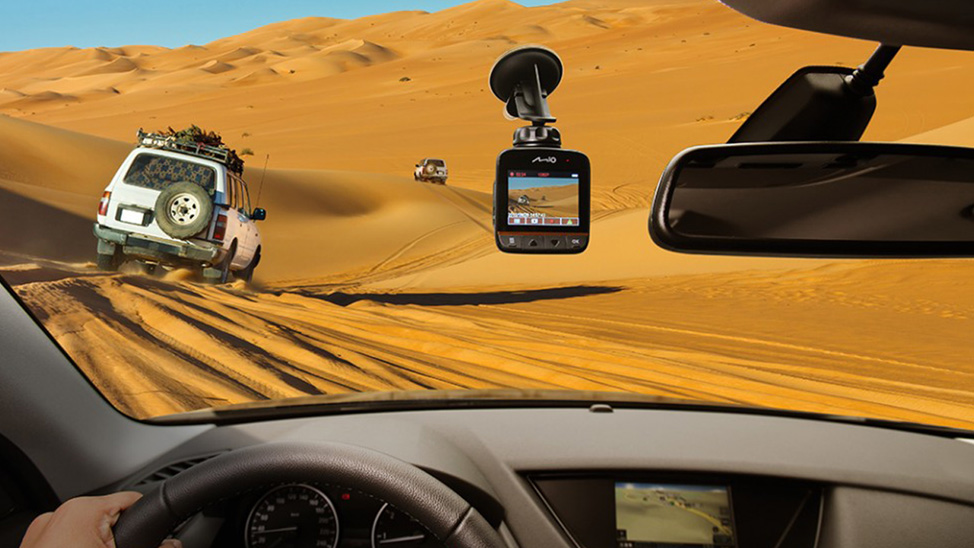TechRadar Verdict
Slick and super easy to use, Mio's drive recorder simply gets the job done
Pros
- +
Stupendously easy to use
- +
Includes speed camera warnings
- +
Records location, speed and heading
Cons
- -
Potential for cable clutter
- -
Pricey stand alone device
- -
Captures your bad driving as well as good
Why you can trust TechRadar
There's a war out there on Britain's roads and it's becoming a case of every man for himself. OK, that's just a teensy bit hyperbolic. But the Mio MiVue 388 drive recorder might just make a difference to your long-term survival - as a fully licenced driver, at least.
The UK's road are undoubtedly as congested and treacherous as ever. And we're not just talking about genuine accidents. Car insurance fraud is commonplace, with crews of criminals drawing unsuspecting road users into minor accidents courtesy of what's known as the 'flash-for-cash' scam.
Essentially, criminals flash their headlights at other drivers to indicate they are letting them out of a junction, only to crash into them on purpose. By the strict letter of the highway code, it's the car pulling out that's at fault. You, in other words.
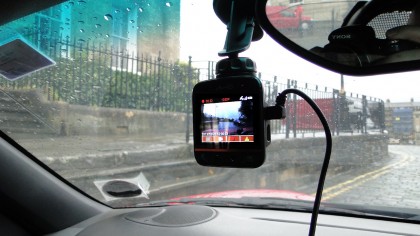
Of course, real accidents happen all the time and that opens up drivers to all manner of liabilities. Likewise, it's not entirely unheard of for the police or the equipment used to enforce traffic regulations to make errors.
Whatever the scenario, having a high definition recording to hand, complete with GPS location and speed data could be a very powerful tool for proving who is at fault or what really happened.
Enter the Mio MiVue 388 drive recorder. It's got all that and more on the tin. For starters, there's video recording up to 1080p and 13Mbits per second.
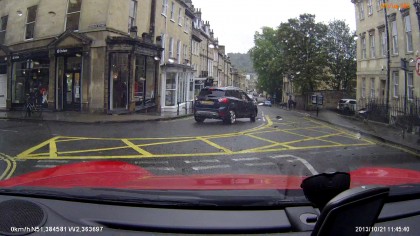
Then there's GPS tracking that allows video footage to be tagged with speed, location, altitude and heading data. Being GPS-enabled means the Mio MiVue 388 knows where it is at all times. Add in a speed camera database and awareness of local speed limits, and you can be warned when approaching cameras and provided with a reference of the maximum permissible speed.
Adding to the situational awareness is a g-sensor designed to detect sudden motions like impacts or emergency steering inputs. Handily, the Mio MiVue 388 also has a 2.4-inch display, which is mainly useful for ensuring you have the camera pointing in the optimal direction. Rounding out the main feature set is mini HDMI for hooking up the Mio MiVue 388 directly to an HDTV.
Finally, Mio provides software for review, playback and sharing of your drive videos.
Performance
When it comes to assessing this kind of drive recording device, there are limitations. Exactly how it performs in a real crash isn't something that's easy to test.
However, we can get a very good feel for the Mio MiVue 388 features and performance. The device itself is relatively compact, with a 2.4-inch display and controls on the rear and an HD camera on the front.
It comes with the usual suction-cup type mounting, but also with a set of clips with sticky pads. The idea is that the clips allow you to secure the power cable, which plugs into a standard 12V car socket, neatly away.
In practice, there's always going to be a bit of clutter unless you go for a full-on pro install that hooks directly into your car's wiring harness. That's especially true of the Mio MiVue 388 if you mount it up in front of your rear view mirror, which is the recommended location. Without the clips, you'd simply have a wiring dangling beneath the camera. Not good.
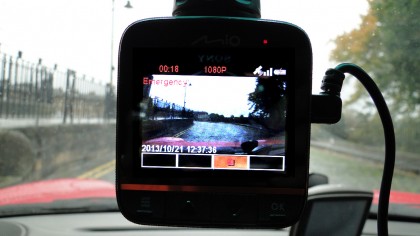
Alternatively, you can mount the camera lower, of course. Whatever, once installed, using the Mio MiVue 388 is delightfully easy. It's pretty much all automatic. By default, it detects the car's wiring harness powering up and immediately begins recording.
The GPS spools up at the same time, though it's worth remembering it might take up to 30 seconds or so before you're hooked into the satellites.
Anyway, it's all pretty much painless in use. But is it perfect. Once problem we had at default settings involved incorrect event trigging due to the g-sensor. The idea is for the device to record a protected file when an event like a collision or evasive movement is detected.
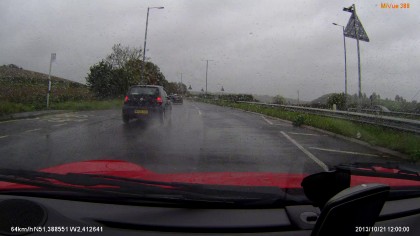
Problem is, we found the event monitor going off when hitting bumps in the road. However, we ran our tests in a fairly firmly suspended Porsche. What's more, the g-sensor's sensitivity is adjustable. The slight snag here is that while it's easy enough to dial it down to exclude false events, it's not clear how low you can go with the sensitivity before you risk missing real events.
On balance, a few false positives are probably the way to go. But what of the video capture function and the image quality? The latter won't scare a GoPro, that's for sure. But it's plenty good enough to get the job done.
The Mio MiVue 388 comes with an 8GB microSD card. At the highest 1080p video setting, the capture quality translates into 100MB per minute or 80 mins of rolling capture time. Leave it running and after 80 minutes, it will begin recording over old footage – unless that footage is marked as an event, in which case it is protected.
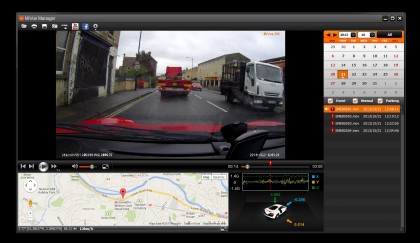
Testing the speed camera database comprehensively is another tricky task. But the Mio MiVue 388 accurately delivered warnings for the location and relevant speed limit of our local cameras. It's a handy little extra.
As for the Mio MiVue Manager software, like the device itself, it's easy to use and gets the job done nicely. There's a Googlemaps pane that tracks your car as it progresses, easy access buttons for sharing on Youtube and more.
Verdict
The Mio MiVue 388 is one of those weird products that's likely to be at it's most useful when something has gone horribly wrong, like a car accident or a speed prosecution gone bad.
We liked
For the most part, it does exactly what it says on the tin. Best of all, it's incredibly easy to setup and use. It really is just a case of shoving in a memory card, sticking it to your windscreen and plugging in the power. Everything else is automatic.
The video quality is good enough, the speed camera warnings work as advertised and the management software is a pleasant if non-essential flourish.
We disliked
The only real downsides are clutter and cost. If you already have an aftermarket satnav hanging from your windscreen, things will get very complicated if your add this drive recorder to the mix.
In that situation, professional installation for one or both is probably the answer, even if that adds cost.
Final verdict
Those caveats aside, it's easy to recommend the Mio MiVue 388. It's a slick little bit of kit.
Of course, it's also worth remembering that it will record your bad driving as well as good. Have a serious own-fault accident and the footage could seal your fate.
But that's no fault of this camera. And for those of us who generally try to driving with consideration for others, the Mio MiVue 388 is a handy weapon to have in the face of the more selfish, aggressive and dangerous breeds of road users.
Technology and cars. Increasingly the twain shall meet. Which is handy, because Jeremy (Twitter) is addicted to both. Long-time tech journalist, former editor of iCar magazine and incumbent car guru for T3 magazine, Jeremy reckons in-car technology is about to go thermonuclear. No, not exploding cars. That would be silly. And dangerous. But rather an explosive period of unprecedented innovation. Enjoy the ride.
